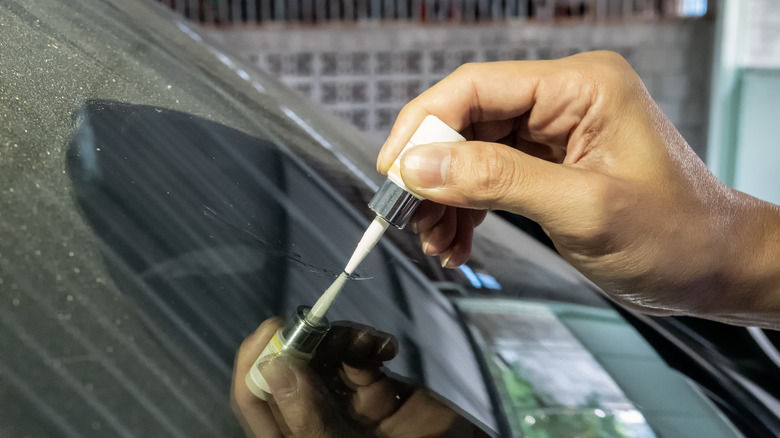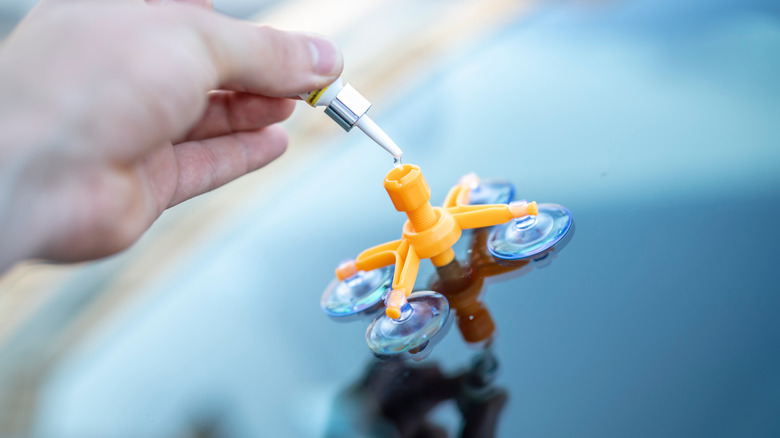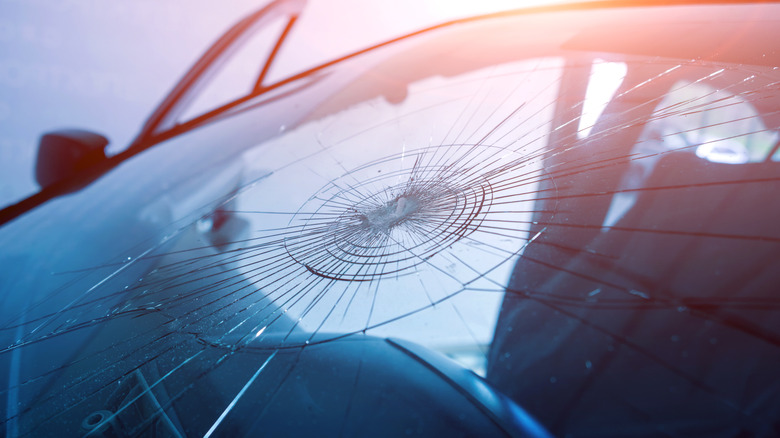3 Ways To Stop A Cracked Windshield From Getting Worse
It's no secret that driving with a cracked windshield carries significant risks that can compromise the safety of a car, truck, or SUV. One of the primary dangers is the reduction in the driver's field of vision. A crack, especially if it's large or located directly in a person's line of sight, can obstruct the view of the road, other automobiles, and pedestrians. This risk is heightened at night when visibility is already reduced, and the unwanted breach can cause light from oncoming traffic to refract unpredictably. During the day, the break in the glass can reflect sunlight directly into the eyes of the person behind the wheel, creating a blinding glare that can momentarily impair the eyesight of the individual driving, leading to a higher risk of accidents.
A crack in the windshield can also interfere with the proper deployment of airbags. In many modern vehicles, airbags rely on the windshield as a backstop to deploy correctly, so if it's compromised, it may not provide the necessary support, leading to possible issues during the event of a collision. Another critical concern is structural integrity, particularly in rollover accidents. The windshield is known to contribute to the overall strength of the cabin structure, and any crack can potentially make the roof more susceptible to collapsing during this particular type of incident.
Furthermore, an already damaged windshield is more likely to shatter should the event of an impact take place, sending glass shards flying inside, which can cause severe injuries to the occupants. Given these risks, it is vital to repair or replace a cracked windshield promptly, and luckily, there are a few ways to ensure the problem doesn't get any worse before it goes in to be professionally fixed.
Apply superglue or clear nail polish
A short-term solution to the cracked windshield dilemma involves super glue or clear nail polish and, if done correctly, could very well prevent things from escalating into a possible glass-tastrophe. The affected area should be thoroughly cleaned beforehand, as any unwanted particles, such as dirt, can interfere with the adhesive's ability to bond to the glass. Once this is done, a small amount of clear nail polish or super glue should be deployed directly into the chip or crack.
Both substances are very effective because they can seep into the tiny crevices and create a seal that prevents the break from spreading. It's important to apply either one very carefully, covering the entire length of the fracture in the glass without using an excessive amount, which could lead to further issues of visibility.
After implementing the super glue or nail polish, vehicle owners must allow it to dry completely because this process is what solidifies the bond. Depending on the product used and environmental conditions, this could take several minutes to a few hours. Once dry, placing a piece of clear packing tape over the area provides an additional layer of protection. This helps to keep out dirt and moisture, which can make matters much worse, especially if the weather changes.
It also adds a physical barrier, protecting the repaired area from external forces. While this is effective for small blemishes, it is wise to keep in mind that this method is not a permanent fix. Afterward, it will need to be determined by a professional if it can be repaired or if a complete replacement is required.
Use a windshield repair kit
Another practical and cost-effective maneuver to prevent cracks from worsening over time is taking full advantage of windshield repair kits. Consumers can find them readily available at most automotive stores, and they will include all the necessary components to perform the DIY quick fix. They typically contain a resin adhesive, a stabilizing device, and curing strips.
The process starts with making sure the area is clear of any sort of contaminants because anything left on the glass can hinder this method's chance of success. After the crucial cleaning step is completed, the stabilizing device is attached to the crack. This device often includes a syringe or tube for injecting the resin, which then fills the crack by entering and forging with the tiny crevices and gaps within the windshield. Once injected, a curing strip is placed over the resin, and exposing it to sunlight will cause it to harden, bonding it strongly to the glass and restoring some of the windshield's original strength and clarity. It is important to follow the kit's instructions precisely for the best results.
The effectiveness of these particular repair kits largely depends on the size and type of the crack. They are most effective on breaks that are no longer than a dollar bill. While they most certainly can be a difference-maker that reduces the chances of the rupture spreading, they are not a complete solution. A professional appraisal is advised to determine the next moves to smooth out the glass's cracks.
Avoid sudden temperature changes
A final preventative measure worth taking to stop the spread of a crack across the windshield in its tracks is simply avoiding sudden temperature changes. When a rapid alteration in the surrounding climate occurs, the glass on a vehicle expands or contracts unevenly, putting additional stress on any compromised areas, like breaks or chips. This is why it is probably a good idea to park the car in a garage, especially during extreme weather conditions.
In the summer, when it's known to get very hot, finding a spot in the shade can minimize the impact of the sun's rays on any crack, reducing the risk of things getting worse before they get better due to heat expansion. As far as colder climates are concerned, shielding the vehicle from direct exposure to frigid elements can prevent the glass from contracting too quickly, which would stop any cracks from causing any additional harm.
It's also important to avoid using the car's window defroster. Having warm air applied to clear condensation or ice can cause a rapid temperature increase in the glass that can make things worse for a cracked windshield, as the rapid expansion around the site of the damage can not only possibly lead to spreading but could even cause new cracks to form.
The safest approach is to avoid using the defroster until the necessary repairs have been completed. This approach, and the others mentioned, will hopefully be able to help maintain a damaged windshield. While these techniques can keep certain cracks in check for a limited time, it's best to seek professional repair or replacement services as soon as possible.



